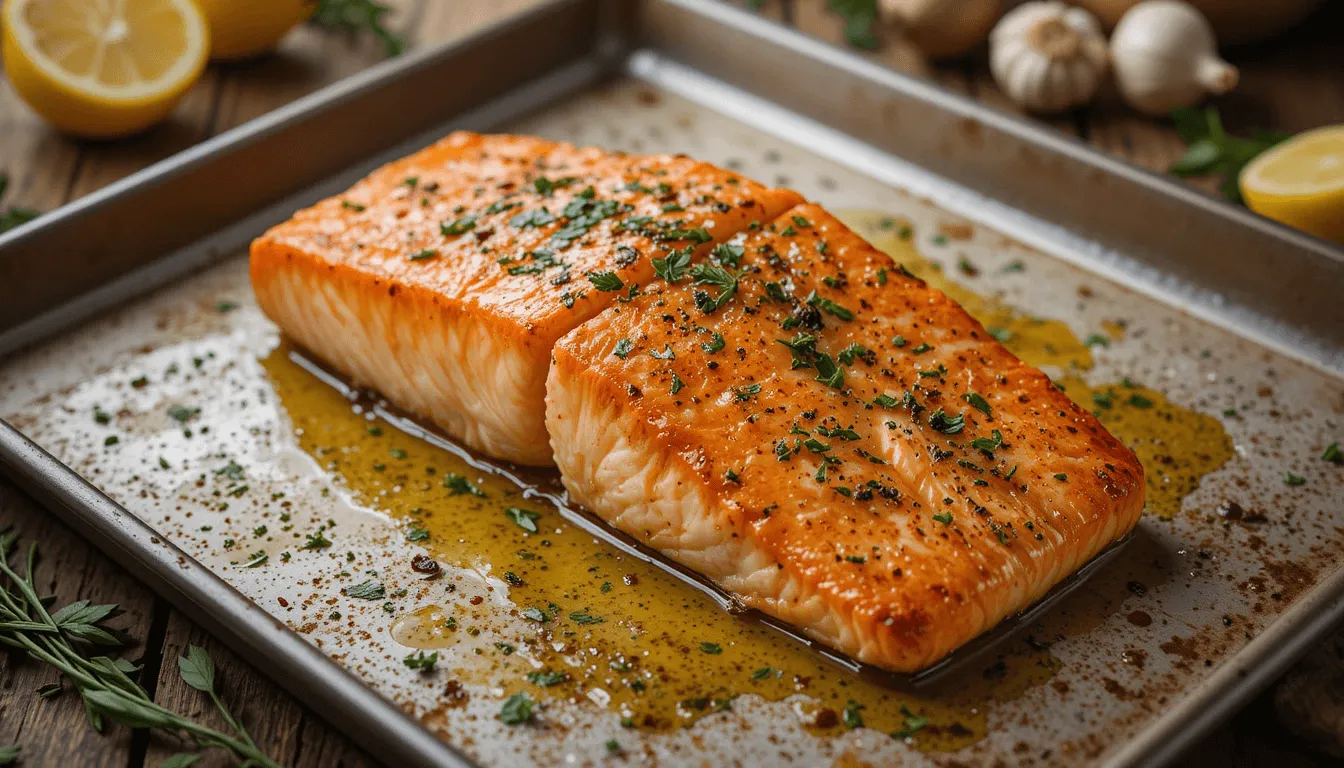Cooking salmon right is key to bringing out its best flavors. Learning to cook salmon in the oven is a great way to make a tasty and healthy meal. It might seem hard, but with the right methods and tools, you’ll soon be enjoying perfectly cooked salmon.
Starting your journey to oven-baked salmon perfection is exciting. Remember, practice is key. This guide will teach you the basics of cooking salmon, from prep to seasoning. You’ll also learn the secrets to making a delicious dish every time you cook salmon in the oven.
Table of contents
Essential Equipment for Oven-Baked Salmon
To cook salmon in the oven, you’ll need some basic equipment. You’ll need a baking sheet or pan that can handle high oven temperatures. A good quality baking sheet is key for cooking salmon in the oven.
You’ll also need tools like a spatula and tongs to handle the fish. These tools are crucial for cooking salmon in the oven.
A thermometer is very important. It helps make sure your oven is at the right temperature. This is vital when cooking delicate fish like salmon. The right equipment ensures your salmon is cooked perfectly.
Some other useful tools include a wire rack for the baking sheet and a silicone mat for easy cleanup. Here are some essential items to get you started:
- Baking sheet or pan
- Thermometer
- Spatula and tongs
- Wire rack (optional)
- Silicone mat (optional)
Using the right equipment and tools can greatly improve your dish. By investing in these basic items, you’ll be on your way to making delicious oven-baked salmon.
Choosing the Perfect Salmon for Oven Cooking
Choosing the right salmon for oven cooking is key for great taste and texture. You can pick from Atlantic, Pacific, or wild-caught salmon. Freshness matters, so look for best salmon for oven cooking with a nice smell and firm feel. If using frozen salmon, thaw it well before cooking.
For cooking salmon fillets, consider these tips:
- Choose fillets that are the same thickness for even cooking
- Go for fillets with more fat for better flavor and moisture
- Think about the salmon’s origin, as some have stronger flavors
Some top picks for oven cooking include:
- Atlantic salmon: mild flavor and firm texture
- Pacific salmon: richer flavor and more fat than Atlantic
- Wild-caught salmon: stronger flavor and texture than farmed
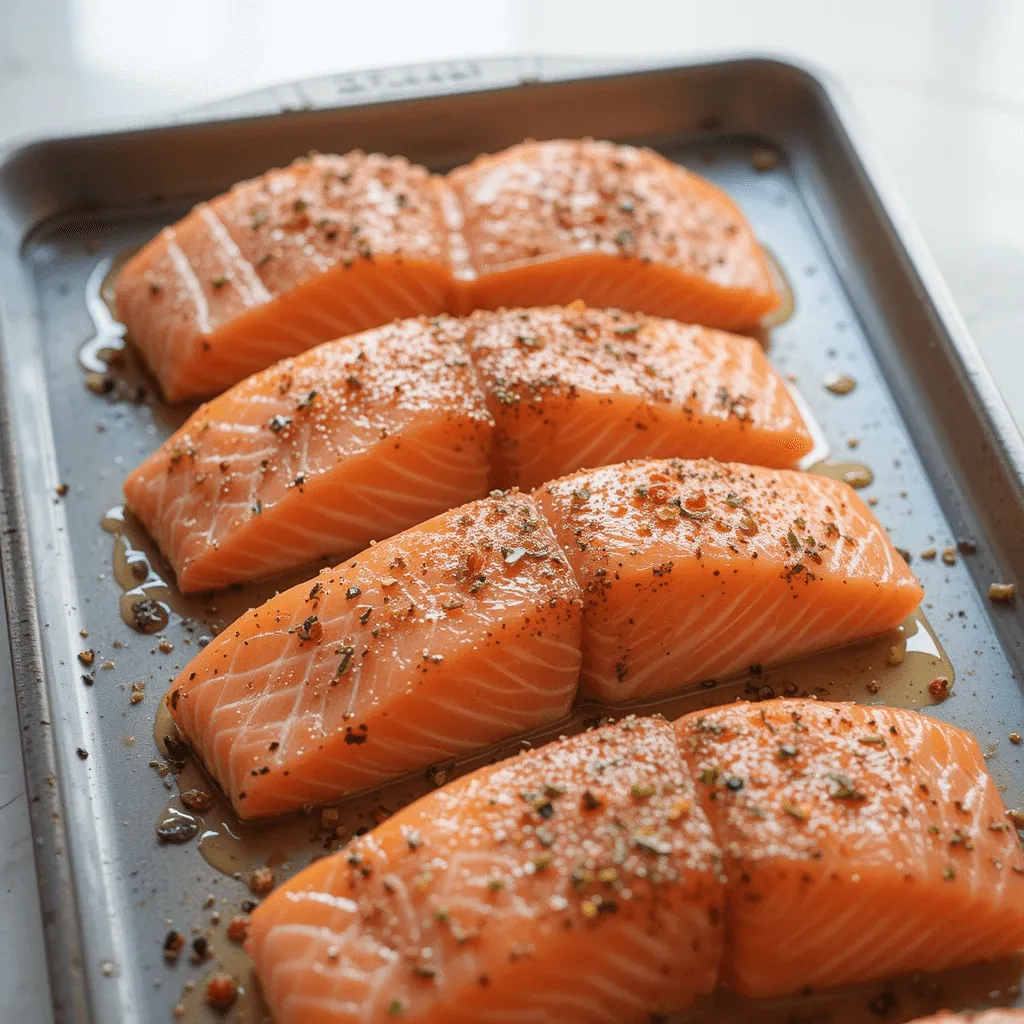
By picking the right salmon and cooking it right, you get a tasty and healthy meal. Always check the salmon’s freshness and quality. Cook it to the right temperature for safety.
Preparing Your Salmon Before Baking
Start with fresh or frozen salmon fillets when baking. If frozen, thaw it first. You can thaw it in the fridge overnight or with cold water.
After thawing, prepare the salmon for baking. Remove any pin bones and cut it into portions. Use tweezers or a fish bone remover for the bones. Then, cut the salmon into individual pieces with a sharp knife.
Proper Thawing Methods
There are a few ways to thaw salmon fillets:
- Refrigerator thawing: This is the safest method, as it allows the salmon to thaw slowly and prevents bacterial growth.
- Cold water thawing: This method is faster than refrigerator thawing, but it requires more attention. You’ll need to change the water every 30 minutes to prevent bacterial growth.
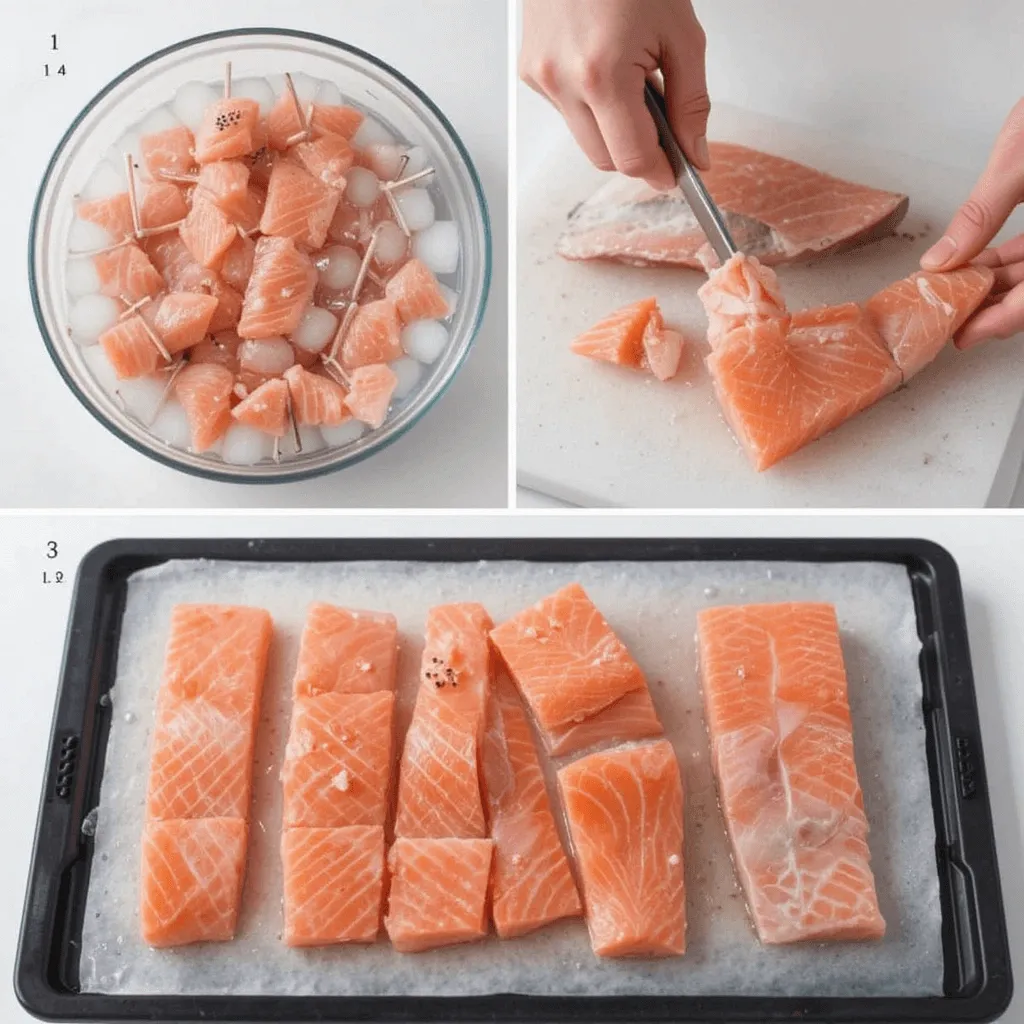
Portioning Your Fish
Portioning your salmon makes cooking and serving easier. You can cut it into individual fillets or smaller pieces. Make sure the pieces are similar in size for even cooking.
| Salmon Portion Size | Cooking Time |
|---|---|
| 6 ounces | 8-12 minutes |
| 8 ounces | 12-15 minutes |
| 10 ounces | 15-18 minutes |
How Do You Cook Salmon in the Oven: Step-by-Step Method
To cook salmon in the oven, start by heating your oven to 400°F (200°C). This step is key for even cooking. Place your salmon fillets on a baking sheet covered with parchment paper or a silicone mat.
Then, drizzle oil over the salmon and season with herbs and spices. You can add flavors like lemon, garlic, or dill. This makes your salmon taste unique. Here’s what to do:
- Place the salmon on a baking sheet lined with parchment paper or a silicone mat
- Drizzle with oil and season with herbs and spices
- Bake in the preheated oven for 12-15 minutes per pound, or until the salmon reaches your desired level of doneness
When cooking salmon in the oven, remember the cooking time changes with the size and thickness. Cook for 12-15 minutes per pound, or until it’s 145°F (63°C) inside. These steps help you make a tasty and healthy oven-baked salmon recipe for any event.
Temperature Guidelines for Perfect Salmon
Getting the temperature right is key when cooking salmon. It ensures the salmon is not only tasty but also safe to eat. The perfect internal temperature for salmon is 145°F (63°C), which means it’s medium doneness. But, everyone likes their salmon differently, so knowing the various doneness levels is important.
To check if your salmon is done, you can use a food thermometer or look for visual signs. For a rare salmon, aim for an internal temperature of 120°F (49°C). Medium-rare is about 130°F (54°C). If you like it well-done, it should be at least 160°F (71°C).
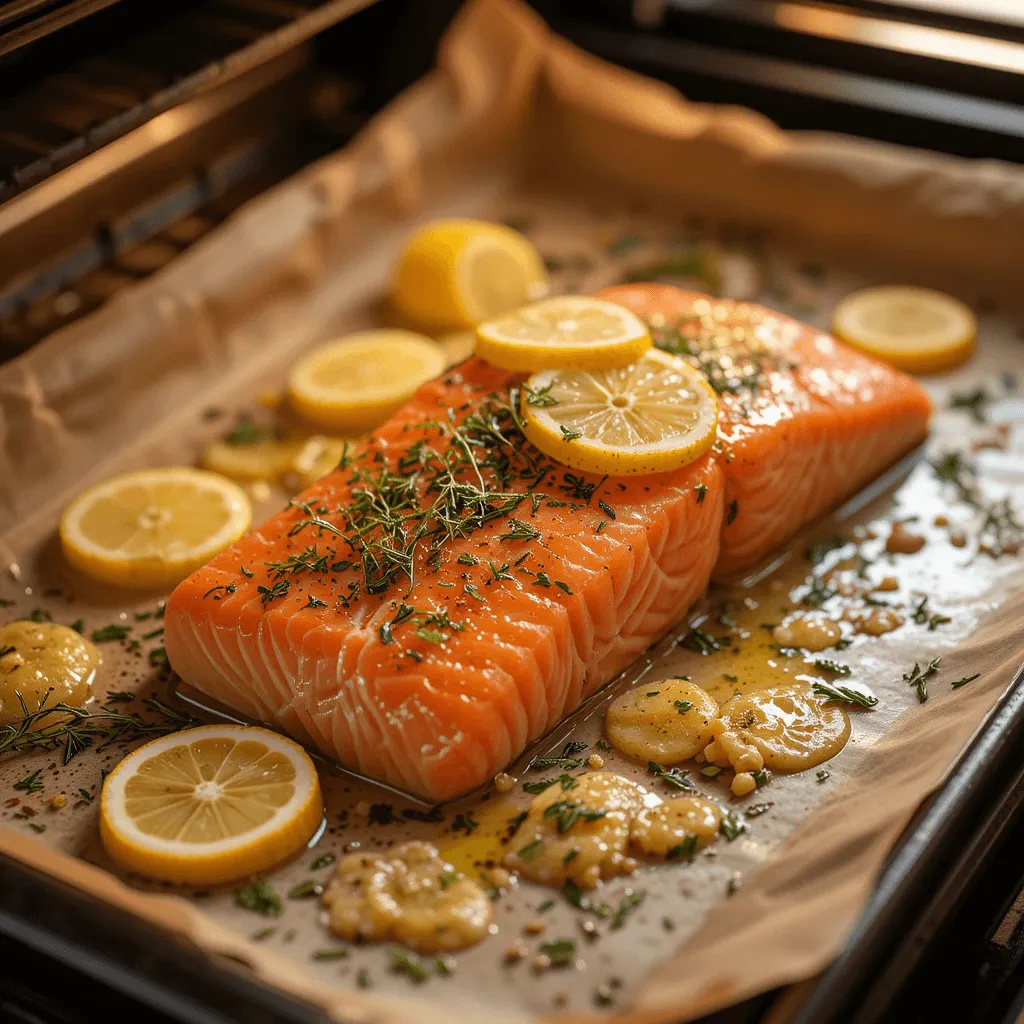
Different Doneness Levels
- Rare: 120°F (49°C) – 130°F (54°C)
- Medium-rare: 130°F (54°C) – 135°F (57°C)
- Medium: 140°F (60°C) – 145°F (63°C)
- Medium-well: 150°F (66°C) – 155°F (68°C)
- Well-done: 160°F (71°C) or higher
Cooking times can change based on the salmon’s weight. So, it’s crucial to watch the temperature and adjust the cooking time as needed. By following these guidelines and knowing the different doneness levels, you can cook salmon perfectly every time.
| Weight (lbs) | Cooking Time (minutes) |
|---|---|
| 1-2 lbs | 8-12 minutes |
| 2-3 lbs | 12-15 minutes |
| 3-4 lbs | 15-18 minutes |
Seasoning Options for Oven-Baked Salmon
Choosing the right seasoning for oven-baked salmon can make a big difference. There are many salmon seasoning ideas to pick from. You can make a flavor that you love.
Think about what flavor you want. Do you like Mediterranean, Asian, or classic American? Pick your seasonings based on that.
Some great seasoning for oven-baked salmon choices are:
- Lemon juice and herbs like dill or parsley
- Asian-inspired flavors like soy sauce and ginger
- Classic American seasonings like paprika and garlic powder
Want to add more flavor? Try mixing lemon juice with herbs or soy sauce with honey and ginger. Spices like cumin or coriander can also add depth.
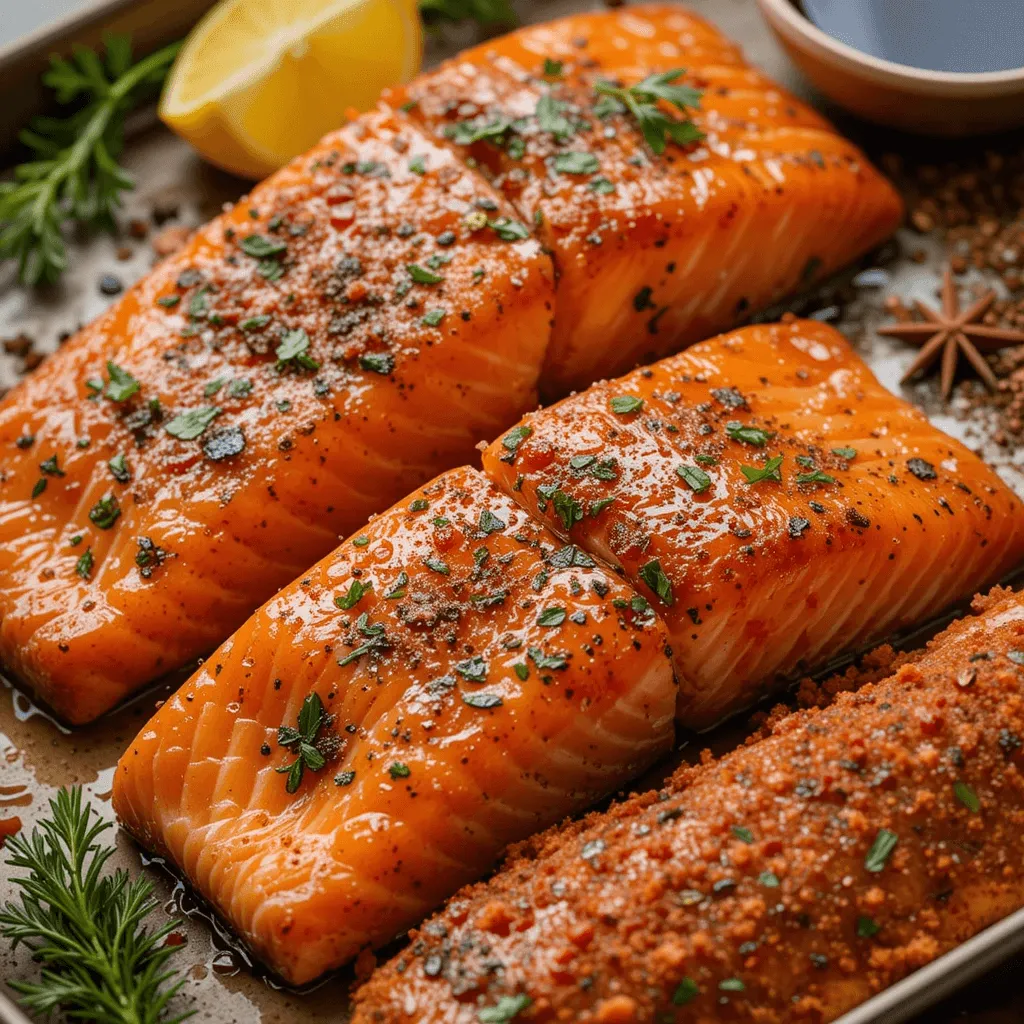
Remember, finding the best seasoning for oven-baked salmon is all about trying new things. Have fun with different salmon seasoning ideas. Keep trying until you find your favorite.
Best Marinades and Glazes for Salmon
Using the right marinades for salmon can make oven-baked salmon taste amazing. You can pick from many marinades, each with its own taste. For a classic taste, mix soy sauce, brown sugar, and garlic. This mix is great for those who like a bit of sweetness and savory flavors.
For something different, try Asian-inspired marinades. Use ginger, sesame oil, and honey for a unique flavor. Or, for a Mediterranean twist, mix olive oil, lemon juice, garlic, and oregano. This creates a fresh and bright taste.
Glazes can also add a lot to your salmon. Apply them in the last few minutes of cooking for a sticky, caramelized crust. You can use honey, soy sauce, and brown sugar, or olive oil and lemon juice. Feel free to mix things up to make your own glaze.
Here are some popular marinade and glaze recipes for salmon:
- Classic: soy sauce, brown sugar, garlic
- Asian-inspired: ginger, sesame oil, honey
- Mediterranean: olive oil, lemon juice, garlic, oregano
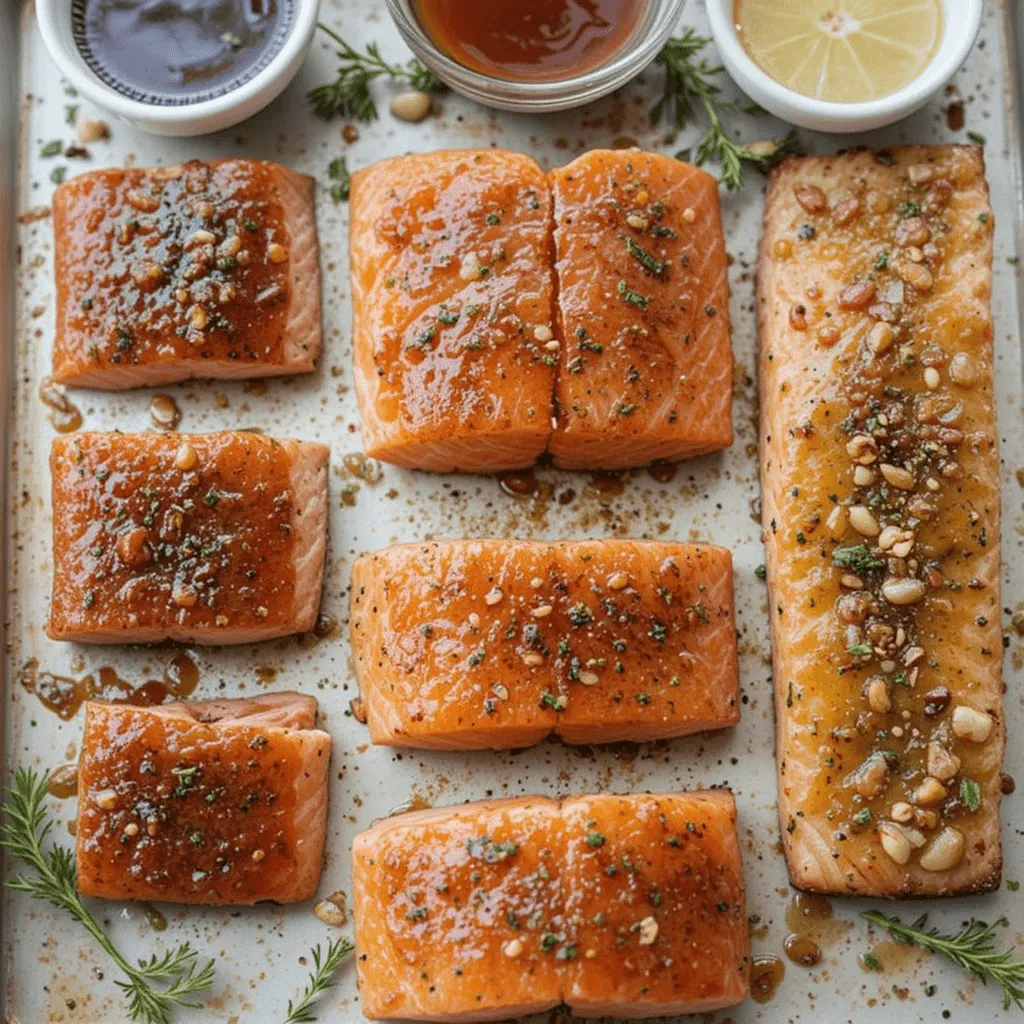
Remember to adjust the marinade or glaze based on your salmon’s size and thickness. With these marinades and glazes, you can make a delicious dish that will wow your guests.
| Marinade | Ingredients | Flavor Profile |
|---|---|---|
| Classic | soy sauce, brown sugar, garlic | sweet and savory |
| Asian-inspired | ginger, sesame oil, honey | exotic and sweet |
| Mediterranean | olive oil, lemon juice, garlic, oregano | bright and refreshing |
Preventing Common Mistakes When Baking Salmon
To cook salmon perfectly, it’s key to avoid common mistakes. Overcooking makes the fish dry and tough. Under seasoning can make it taste bland. Also, make sure your oven is at the right temperature and don’t overcrowd the baking sheet.
Some common mistakes cooking salmon include:
- Overcooking, which can be avoided by checking the internal temperature of the fish
- Under seasoning, which can be prevented by using a variety of herbs and spices
- Not patting the fish dry before cooking, which can lead to a soggy texture
By avoiding these mistakes, your salmon will always be delicious. Always check the fish’s internal temperature and adjust cooking time to avoid common mistakes cooking salmon. With practice, you’ll master cooking salmon perfectly and enjoy a tasty, healthy meal.
| Mistake | Prevention |
|---|---|
| Overcooking | Check internal temperature, adjust cooking time |
| Underseasoning | Use a variety of herbs and spices |
| Not patting fish dry | Pat fish dry with paper towels before cooking |
Serving Suggestions and Side Dishes
There are many ways to serve oven-baked salmon. You can pick from a wide range of side dishes that go well with its flavor. Try pairing it with roasted veggies like asparagus or Brussels sprouts for a balanced meal.
Vegetable Pairings
Here are some great veggie options for oven-baked salmon:
- Roasted carrots with a hint of lemon and herbs
- Grilled or sautéed spinach with garlic and cherry tomatoes
- Steamed broccoli with a squeeze of lemon and a sprinkle of parmesan cheese
Grain and Starch Options
For grains and starches, serve your salmon with quinoa, brown rice, or roasted potatoes. These options offer a nice contrast in texture to the soft salmon.
Sauce Recommendations
Adding a sauce can make your meal even better. Try a lemon butter sauce, a creamy dill sauce, or a soy-ginger sauce. These sauces can enhance the taste of your salmon and side dishes, making your meal unforgettable.
Conclusion
Learning to cook salmon in the oven is all about paying attention to details. You need to pick the right salmon, season it well, and cook it just right. This guide will help you make delicious salmon dishes that everyone will love.
Remember, practice makes perfect when it comes to how to cook salmon in the oven. It might take a few tries to get it just right. But with time and effort, you’ll become a pro at making oven-baked salmon.
Now that you know the basics, it’s time to get creative. Try out different seasonings, marinades, and sides to create your own special salmon recipe. There are endless possibilities, so have fun and enjoy the journey of improving your salmon-cooking skills.
FAQ
How do you cook salmon in the oven?
First, preheat your oven to 400°F (200°C). Place the salmon fillets on a baking sheet covered with parchment paper or a silicone mat. Drizzle with oil and season with herbs and spices.
Bake for 12-15 minutes per pound, or until it’s cooked to your liking.
What temperature should I cook salmon in the oven?
For medium-doneness, aim for an internal temperature of 145°F (63°C). You can adjust the temperature and time to suit your taste. A range of 400-425°F (200-220°C) is good for oven-baked salmon.
How long do you cook salmon in the oven?
Cooking time depends on the salmon’s thickness. A 1-pound fillet takes 12-15 minutes, while a 2-pound one takes 24-30 minutes.
What type of salmon is best for oven cooking?
You can use Atlantic, Pacific, or wild-caught salmon. Look for fresh, high-quality fillets with a pleasant smell and firm texture. If frozen, thaw it properly before cooking.
How do I season salmon for the oven?
You can season salmon with simple ingredients like salt, pepper, and lemon juice. Or, try more complex marinades and glazes. Choose seasonings based on the flavor you want, like Mediterranean or Asian-inspired.
What are some common mistakes to avoid when baking salmon?
Avoid overcooking, which makes the fish dry and tough. Also, don’t underseason or overcrowd the baking sheet. Make sure your oven is at the right temperature and don’t overcook the salmon.
What are some good side dishes to serve with oven-baked salmon?
Serve oven-baked salmon with roasted vegetables like asparagus or Brussels sprouts. Grains and starches like quinoa or roasted potatoes also pair well. Try sauces like lemon butter or soy-ginger for extra flavor.

